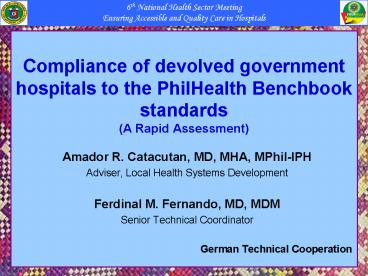Compliance of devolved government hospitals to the PhilHealth Benchbook standards A Rapid Assessment - PowerPoint PPT Presentation
1 / 19
Title:
Compliance of devolved government hospitals to the PhilHealth Benchbook standards A Rapid Assessment
Description:
... factors deficiencies on qualified personnel, training, team processes, skill ... Pre-operative anesthesia. Criteria. Provincial LGU process. 2. Human resources ... – PowerPoint PPT presentation
Number of Views:817
Avg rating:3.0/5.0
Title: Compliance of devolved government hospitals to the PhilHealth Benchbook standards A Rapid Assessment
1
Compliance of devolved government hospitals to
the PhilHealth Benchbook standards(A Rapid
Assessment)
- Amador R. Catacutan, MD, MHA, MPhil-IPH
- Adviser, Local Health Systems Development
- Ferdinal M. Fernando, MD, MDM
- Senior Technical Coordinator
- German Technical Cooperation
2
Introduction
- Quality assurance in health
- Brings greater client satisfaction
- Achieves better health outcome
- Increases effectiveness and efficiency
- Assessment of quality performance
- Establish baseline studies
- For continuous quality improvement
- Objective self-assessment process
3
Introduction
- Section 50 of the Revised Implementing Rules of
the National Insurance Act (RA 7875) as amended
by RA 9241 mandates the Philippine Health
Insurance Corporation to implement the Quality
Assurance Program for hospitals - PhilHealth Circular No. 12, s 2005 adopted
PhilHealth Benchbook on Performance Improvement
of Hospital Services to assess and evaluate the
performance of the facilities based on quality
standards - PhilHealth Circular No. 12, s 2006 requires all
hospitals applying for accreditation to have a
Continuous Quality Improvement Program beginning
January 2007
4
PhilHealth Benchbook
5
Objectives of the Study
- To assess the compliance of devolved government
hospitals in operationalizing the PhilHealth
Benchbook - To enumerate the most common causes of partial
and non-compliance to the standards - To evaluate the applicability of partial and
non-compliant standards
6
Methodology
- Rapid Assessment
- Population samples
- 11 provincial hospitals (4 from Luzon, 3 from
Visayas, and 4 from Mindanao) 6 are categorized
as level 3 facilities 5 are level 2 facilities - 10 district hospitals (4 from Luzon, 2 from
Visayas and 4 from Mindanao) 7 are level 2
facilities and 3 are level 1 facilities - Survey using Benchbook criteria
- Percentage of compliance full, partial, none
- Percentage of applicability of the partial and
non-compliance to the hospital setting
7
Presentation of results
- Percentage compliance to the Benchbook criteria,
Provincial Hospitals, 2007
8
Presentation of results
- Percentage compliance to the Benchbook criteria,
District Hospitals, 2007
9
Presentation of results
- Reasons for partial and non-compliance to the
PhilHealth Benchbook standards
10
Presentation of results
- Policies and procedures not written, not
monitored - Organizational processes lack of planning,
implementing, managing, monitoring, evaluating,
informing/feedbacking/reporting, and completing
requirements - Structural components lack of forms,
deficiencies in patient rooms, passageway,
directional signs, information on services,
equipment maintenance, program/management
structures and plans, record keeping,
agreements/contracts, relevant licenses, and
resources - Human resource factors deficiencies on
qualified personnel, training, team processes,
skill mix, capability, recruitment, selection,
appointment, training, roles and responsibilities
- Patient aspects deficiencies in patient
involvement in health, understanding of their
roles and responsibilities, how they are
accommodated to access services, patient safety,
and observing patient rights.
11
Presentation of results
- Percentage applicability of partial and
non-compliant criteria to the Provincial
Hospitals, 2007
12
Presentation of results
- Percentage applicability of partial and
non-compliant criteria to the District Hospitals,
2007
13
Presentation of results
- Criteria not applicable to hospital setting and
reasons for non-applicability
14
Recommendations in addressing the gaps
- Organizing the quality management structure
- Quality TWG / Quality Circle
- Identification of QC roles and responsibilities
- Integration of QC in the organizational chart
15
Recommendations in addressing the gaps
- To deal with ownership and organizational issues,
the Quality Circle is guided by - Buying-in after the orientations
- Putting local flavor to Benchbook standards
- Working on existing structures and resources
- Capacity building for leadership and Quality
Circle - Advocating quality culture view QAP as program
of self-assessment and development, not a program
of requirement
16
Recommendations on addressing the gaps
- 2. Writing the Manual of Quality Policies and
Procedures - The Manual serves as a reference document and
guide for the quality assurance program of the
hospital - The Manual contains
- Vision-Mission statements
- General Organizational Quality Policy and Quality
Goals - Quality Policies and Procedures for (1) the
Benchbook standards and (2) the clinical and
non-clinical service areas - Monitoring and Evaluation Tool Indicators,
Targets, Document Source, Responsibility and
Monitoring Frequency
17
Recommendations on addressing the gaps
- 3. Other recommendations (supporting structures)
- PHIC
- Re-visit, re-validate, re-evaluate non-applicable
standards and criteria - PRO
- Continuous advocacy to implement Benchbook
standards - DOH
- National policy on quality integrating the
internationally acceptable dimensions of quality
(e.g. effectiveness, efficiency, equitability,
safety, accessibility, acceptability) - CHD
- Training of trainers for quality management
system of the Benchbook - Monitoring and evaluation of QAP
18
Conclusions (Over-all Messages)
- Feasible to operationalize the Benchbook
standards and criteria - Better understanding of partial and non-compliant
areas as areas for improvement - Guidance for capacity building (orientation,
methods, tools) on quality assurance and
continuous quality improvement to create quality
culture - Policy/ enabling environment
- Institutional/ organizational environment
- Human resources
19
Thank you very much!































